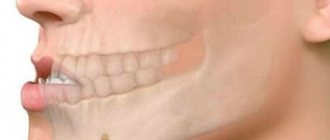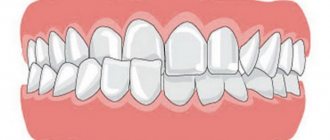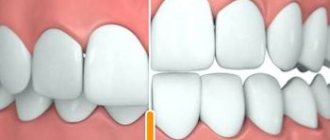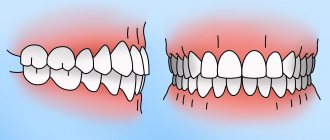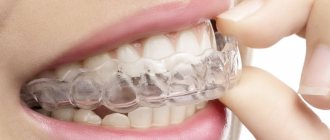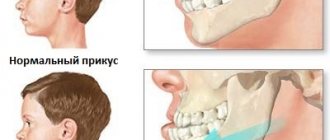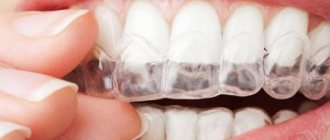Chief editor of the site:
Snitkovsky Arkady Alexandrovich
Chief physician of the professorial dentistry “22 Century”, dentist, orthopedic dentist
Author of the article:
Scientific team of dentistry “22 Century”
Dentists, candidates and doctors of medical sciences, professors
Types of pathological bite
Occlusion is the mutual arrangement of the dentition with their maximum contact. Correct bite is very important - it ensures:
- Uniform load on the teeth during chewing;
- Chewing food thoroughly;
- Clear diction;
- A beautiful smile;
- Normal tone of facial muscles.
According to statistics, up to 80% of people have various malocclusions. High-quality diagnostics and effective correction of malocclusion are carried out in the clinic of professorial dentistry “22 Century”.
Bite formation occurs at an early age and depends on many factors. In the recent past, correcting malocclusion in adults was considered impossible. Today, orthodontics has an impressive arsenal of means to eliminate defects in the location of the dentition.
Various types of pathological bite
According to statistics, up to 80% of people have various malocclusions
Mesial occlusion (progenia)
The presence of a mesial bite , characterized by an anterior position of the lower jaw relative to the upper jaw, can often be determined even visually - by the protruding lower jaw.
Deep bite
Holders of a deep bite , in which the incisors of the upper jaw overlap the incisors of the lower jaw by more than a third, can be visually distinguished by a deep mental fold and a shortened lower part of the face.
Distal bite (prognathia)
The external manifestation of a distal bite, in which the upper incisors are located far ahead of the lower ones, is the upper jaw unnaturally pushed forward.
Crossbite
A crossbite is characterized by a narrowing of the lower or upper jaw with a displacement of the lower jaw to the side. An external sign of such a defect is pronounced facial asymmetry.
Open bite
With an open bite, the teeth of the upper and lower jaws do not contact each other in some area.
Alignment methods for adults
Teeth straightening without braces in adult patients is used only in cases of uncomplicated pathologies. For example, the use of aligners - transparent trays made of polymer materials - allows you to correct the unevenness of the incisors and the density of the dentition.
To correct and disguise smile defects in adults, use:
- aligners;
- veneers and lumineers;
- prosthetics;
- restoration with composite materials.
At the same time, a corrective effect without unpleasant consequences is provided only by the use of aligners, the cost of a course of treatment of which in some cases is significantly higher than the price of a braces system. But even high-quality mouthguards will not help straighten teeth without braces for adults with serious pathology.
Teeth straightening with aligners
Aligners
- These are orthodontic aligners made of transparent polymers. Elastic but resilient supports placed over the upper and lower jaws that apply gentle pressure to guide the teeth into the correct position.
Aligners for teeth straightening
Teeth straightening with aligners occurs gradually and includes regular replacement of linings with denser ones. Each mouthguard is made individually based on the patient's orthodontic impressions.
Duration of treatment
depends on the complexity of the pathology and the type of aligners used. On average, it is 8-12 months of continuous - at least 20 hours a day - wearing the pads. If the expected correction time exceeds 1 year, then it is recommended to resort to teeth straightening with braces, as a faster and more effective method.
Types of aligners.
The effectiveness of treatment and its cost depend on the correct choice of an orthodontic mouth guard. Different manufacturers use their own technologies for producing aligners, and not all of them meet modern requirements. Therefore, when choosing devices, follow your doctor’s recommendations and give preference to certified products that have been tested and have real patient reviews.
Let's look at the most popular brands of orthodontic aligners used in Russian clinics:
Aligner Manufacturers
- Invisalign
is a development of Aling Technology (USA), the most experienced aligner manufacturer in the world. The mouthguard is manufactured using high-tech ClinCheck Pro software, which allows you to accurately predict the final result of therapy. With the help of this company's product there is a high probability of correcting severe malocclusions. The cost of a course of treatment, which involves replacing the lining every two weeks, ranges from 168 thousand rubles. - OrthoSnap
is an American company that produces more affordable aligners. Mouthguards are made from our own materials using Dynamic Physical Model technology without the use of computer modeling. Effective against minor defects such as diastema, crooked teeth. They do not allow you to predict the result. The cost of treatment with OrthoSnap aligners starts from 100 thousand rubles. - Star Smile
is a Russian analogue of American designs, produced by a young company. Uses 3D modeling programs, but does not have high manufacturing technologies. The use of aligners from this manufacturer gives good, predictable results in correcting minor defects in the anterior teeth. Due to the reduction in delivery costs, the price of treatment is lower than when using foreign aligners (from 80 to 160 thousand rubles). - Avantis 3D
is another Russian brand. In the production of aligners, we also use computer modeling and 3D technologies. This is one of the most affordable methods of treating jaw pathologies; the cost of treatment starts from 40 thousand rubles. But these mouthguards are not capable of correcting severe disorders.
The feasibility of treating malocclusion with aligners is assessed by an orthodontist. After all, even expensive high-tech mouth guards will not give the expected result in correcting severe pathologies.
Advantages of aligners:
- the ability to remove for eating and dental care;
- invisibility on teeth;
- do not cause allergies;
- do not injure the soft tissues of the oral cavity.
The main positive quality of the onlays is the ability to carry out usual oral hygiene, which significantly reduces the risk of caries.
Transparent aligners are almost invisible on the teeth
Cons of aligners:
- ineffective for severe disorders;
- have high treatment costs;
- cause discomfort when eating in public places;
- long production;
- unreliable fixation.
As we can see, the main disadvantage of the devices is the inability to correct complicated anomalies.
Price.
It directly depends on the chosen brand of aligners. Thus, treatment with Russian-made mouthguards will cost 40 thousand rubles or more, and the cost of using American high-tech developments reaches 280 thousand.
Veneers
Veneers
- These are overlays for teeth made of composite materials or porcelain. Designed to hide aesthetic smile defects.
Veneers are thin plates that are fixed to the outer surface of the teeth. Service life up to 10 years.
Veneers are coverings for teeth
Overlay thickness up to 0.5 mm. To make it look inconspicuous, the enamel is ground down by 0.3–0.7 mm.
It is impossible to straighten teeth with veneers. They are used to mask pronounced defects: chips, cracks, different heights of teeth.
Pros:
- invisible, as they are matched to the color of the patient’s enamel;
- short adaptation period, cannot be felt on the teeth just a few hours after installation;
- quick fixation procedure, instant results.
Veneers are matched to the color of tooth enamel.
Veneers easily cope with their task - masking unpleasant features of teeth, but do not solve problems with bite.
Minuses:
- the method requires grinding down the enamel;
- the need to repeat the procedure every 10 years or less;
- expensive treatment.
Veneers are used to correct minor defects. Plates are not able to hide pronounced abnormalities in the position of the teeth.
Price.
Installing one record costs 20 thousand rubles and more. The cost depends on the materials used and the complexity of the work.
Lumineers
Lumineers
– these are overlays on teeth, similar to veneers, but unlike the former, they have thin walls (up to 0.2 mm). Due to this difference, fixing the plates does not require cutting down the enamel.
Lumineers are ultra-thin veneers.
Teeth straightening with lumineers is similar in functionality to veneers - they mask smile defects.
Differences between lumineers and veneers.
The fundamental difference is the thickness of the plates, which is at least 2 times smaller for lumineers. This factor allows you to install onlays without grinding down your teeth, making their appearance natural. Lumineers produced using high-tech methods have greater strength and a service life that is twice as long as veneers.
Pros:
- do not require traumatic dental treatment;
- are made individually in a short time;
- do not lose their appearance throughout the entire period of operation;
- do not change tooth sensitivity;
- no different from other teeth.
If for some reason during the period of use it becomes necessary to remove the lumineer, this can be done without harm to the teeth.
Minuses:
- high cost of the record;
- They are not installed on large or strongly protruding teeth.
Price
for the installation of one lumineer from 30 thousand rubles.
Do not forget that with the help of onlays only the correction of external defects is possible, and not the treatment of pathology.
Composite dental restoration
Composite restoration
– a relatively inexpensive way to correct external tooth defects, in which, like filling, irregularities, chips, and stains on the enamel are masked using photocomposite materials.
Restoration of teeth using composite materials
During the work, the doctor first grinds the teeth and applies restoration material, drying each layer with a special lamp with UV radiation. The final layer is tinted to match the natural shade and polished. This technology is called tooth augmentation.
Pros:
- low cost;
- quick effect;
- aesthetics;
- does not require getting used to.
With the help of restoration, you can quickly return a damaged tooth to its correct shape.
Minuses:
- grinding down the tooth and removing the nerve (in some cases);
- service life up to 5 years;
- fragility;
- instability to dyes.
Depulpation (removal of the nerve) is a significant disadvantage of this procedure, as the tooth loses strength. This leads to premature tooth decay.
Price.
This correction method is distinguished by its accessibility. The cost of the procedure for 1 tooth is from 2,000 rubles.
It is impossible to straighten the bite of teeth with a composite material; using this method, part of the bone tissue is removed from the tooth in one place and built up in another, thereby improving the appearance.
Prosthetics with crowns
Dental prosthetics with crowns
– a radical way to correct your bite, which can give you the perfect smile... But at what cost?!
An artificial prosthesis can eliminate almost any external manifestations of malocclusion: curvature of teeth, different heights, gaps. However, this process is accompanied by high traumatism, since before the installation of crowns the enamel is strongly worn down, individual teeth are depulped (the nerve is removed). It turns out that the original, incorrectly positioned teeth are replaced with an ideal, but artificial smile.
Dental prosthetics with crowns
Types of crowns:
- metal ones - inexpensive, installed on the back molars, do not require much grinding of the enamel;
- ceramic – look as natural as possible, but fragile;
- metal-ceramic - strong, matched to the color of the teeth, but thicker, require strong grinding of the enamel;
- plastic ones are cheap, but very fragile and need careful care.
Ceramic crowns for teeth
Alignment of teeth with crowns is used to eliminate external defects and partially correct the bite.
Pros:
- quick results;
- individual production;
- aesthetic appearance.
Despite the positive aspects, the disadvantages of using this method to correct the bite are less pleasant.
Minuses:
- high price;
- the prosthetic procedure is irreversible, the teeth are ground down once and for all;
- Depulpation may be required.
Price:
Making a crown for one tooth costs from 6 thousand rubles. Prosthetic restoration of the front part of the teeth with metal-ceramic crowns costs 100 thousand rubles and more.
To summarize, we can draw the following conclusion:
Safe correction of malocclusion without braces in adults is only possible with the use of aligners, which gently return teeth to their correct position. If correction with mouthguards is not possible, it is recommended to install a brace system as the least traumatic method that allows you to preserve healthy teeth without grinding down the enamel and removing nerves.
Methods for correcting bite
In modern dentistry, teeth bite correction is carried out for patients of any age . Specific treatment methods are chosen individually, taking into account the type of bite, the degree of changes in the dentition, age, condition of the patient’s teeth and the entire body, his lifestyle, aesthetic considerations and other aspects. The duration of treatment also depends on many factors: the chosen treatment method, the condition of the teeth, the age of the patient, and is determined individually .
To correct malocclusion, special mouthguards and dental trainers , plates, and braces are used.
In some cases, surgical correction of the bite is performed.
Is it possible to straighten teeth without braces?
The best way to avoid wearing braces is high-quality prevention of the development of abnormal tooth growth and malocclusion.
It consists of careful oral care starting from infancy, combating bad habits that affect jaw development and timely visits to the dentist to identify and treat pathologies. If the problem could not be prevented, and the teeth have not grown as straight as we would like, it is necessary to begin correction. But is it really possible to straighten teeth without braces?
Adults and children are put off by the need to wear braces for long periods of time. But most often only these, sometimes completely invisible, devices can correct severe pathologies of tooth growth.
Fortunately, some violations can be corrected or disguised without the use of braces:
- slight displacement or twisting of teeth (no more than two in a row);
- too dense or sparse arrangement of teeth;
- uneven height of teeth;
- minor malocclusions (except open);
- chips, cracks and other defects in the integrity of the enamel.
Alternative correction methods are also offered if there are contraindications to wearing braces: early childhood, illness or mental disorders. But in these cases, you can only achieve prevention of dental deterioration, getting rid of bad habits and normalizing natural nasal breathing.
Sometimes teeth can be straightened without braces
Serious jaw pathologies can only be corrected surgically or with the help of brace systems, produced in a large assortment to suit any patient preference.
Stages of bite correction
It is necessary to correct a dental malocclusion after a thorough examination of the oral cavity and the entire body, and diagnosis of dental problems. A painless and high-quality bite correction in Moscow can be carried out in the shortest possible time with maximum effect dentistry “22 Century” .
The process of correcting a bite takes place in three stages:
- At the first stage, the dentition is prepared for the installation of removable or non-removable structures;
- At the second stage, the bite is directly corrected using the selected method;
- The final stage - retention - is necessary to secure the teeth in the correct position.
What is restoration with composite materials?
Composite light-curing material is one of the most popular when carrying out therapeutic procedures and microprosthetics. So-called composite resins have been used in dentistry for more than half a century, but the composition of the materials has been constantly refined and changed to achieve optimal strength and aesthetics. Today, most clinics use hybrid composites, which are superior to previous generation materials in these indicators. The key property of any composite is excellent adhesiveness (contact of the material with the tooth tissue), which is achieved through polymerization. Simply put, under the influence of ultraviolet light the composite hardens, restoring the anatomical shape of the tooth.
Correction of bite with braces
Structurally, such a system consists of arches connected by special locks - braces, fixed on the surface of the teeth.
One of the most common and effective orthodontic techniques is bite correction with a braces system. Structurally, such a system consists of arches connected by special locks - braces, fixed on the surface of the teeth. Due to the tension created by the arches, the teeth are shifted in the required direction and fixed.
Today, various braces systems are successfully used
- Metal,
- Sapphire,
- Ceramic,
- Lingual (installed on the inside of the dentition),
- Self-ligating (providing the most gentle and physiological correction of the position of the teeth).
The choice of a specific type of brace system is made individually for each patient.
In what cases can treatment be done without braces?
First of all, it should be noted that braces have been and remain the most effective in orthodontic treatment. And only in some cases you can do without their help:
· incorrect position of just one or two teeth (rotation, protrusion, retrusion, intrusion of crowns);
mild crowding of teeth;
· the presence of tremata and diastemas (wide dental spaces);
· widened or too narrow dental arch;
· slight deviations of bite from the norm;
allergy to metal;
· psychological discomfort and persistent reluctance to wear braces;
· high risk of injury to low-lying gums when installing braces;
· very low pain threshold;
· lifestyle or work specifics in which braces will interfere.
As can be seen from the indications, orthodontic structures such as aligners and trainers help only in cases where only light bite correction or elimination of small dental defects is required. Serious pathologies will still have to be corrected with braces. However, only a doctor can give a final conclusion on the advisability of using a particular method.
Bite correction using the Invisalign system
One of the newest types of removable structures are transparent aligners of the Invisalign system.
One of the newest types of removable structures are transparent aligners of the Invisalign system . This treatment method involves manufacturing a set of special thin and transparent aligners for the patient using high-precision equipment. All mouthguards have slight differences in shape. The patient wears each one for approximately 14 days and then changes to the next one. As a result, the teeth gradually shift in the required direction, and the bite approaches normal.
Massage for teeth straightening
Massage of the gums and palate is one of the most painless methods of comprehensive correction of dental anomalies. It is carried out while performing hygienic procedures for caring for the oral cavity. Massage in a circular motion along the gums using a medium-hard toothbrush.
As a result of such manipulations, local blood circulation will improve, pain will go away when wearing orthodontic structures, and the alignment process itself will go faster. Regular massage will strengthen your gums and prevent loosening of your teeth.
Surgical methods for correcting malocclusion
In the most difficult cases, the bite is corrected surgically . Indications for surgery are:
- Frontal or lateral open bite,
- Chin dysplasia,
- Facial asymmetry
- And other pathologies.
An operation to correct the bite, depending on the indications, allows, for example, to lengthen the jaw bone or remove part of it to ensure proper closure of the dentition. In modern dentistry, surgical interventions are performed painlessly under general anesthesia. All operations are performed primarily in the oral cavity, so there are no scars left on the patient’s face.
Advantages and disadvantages of dental restoration with composite veneers
- Lower cost compared to ceramic veneers.
- They do not require deep preparation of tooth tissue.
- Good aesthetic indicators (the final result largely depends on the qualifications of the doctor).
- Simple replacement procedure.
- Less strong and durable compared to ceramic veneers.
- They require regular grinding (at least once every six months).
- Over time, dyes are absorbed, which affects aesthetics.
Aligners we offer to patients
3 D Avantis is a domestic analogue of the world famous American system. In terms of quality and efficiency, it is in no way inferior to other aligners, but the cost of treatment and the production time for a set of aligners are noticeably reduced.
Star Smile is a product of a large Russian company. StarSmile aligners are manufactured using ultra-modern equipment. The use of unique UClear technology ensures the highest precision of products. Mouthguards move teeth within specified time frames and are effective against interdental spaces up to 6mm, deep bites, crossbites and crowded teeth.
Invisalign is the most famous American manufacturer of aligners. It was Invisalign that became the pioneers in this area and remains a leader to this day. Small disadvantages for Russian patients may be the long production time for a set of mouth guards, as well as the relatively high cost of the set.
Treatment with transparent aligners
The undoubted advantage of aligners is that you can evaluate the effectiveness of treatment even before it begins. A special computer program calculates the exact timing of using the trays and allows you to visualize the results of treatment. A set of mouth guards is manufactured immediately for the entire period of orthodontic treatment. The patient independently replaces the mouthguard with a new one every two weeks. The mouthguards can be removed when eating, brushing teeth, and in vital situations. They must be worn at least 22 hours a day. The system does not in any way complicate the process of brushing teeth and does not affect the quality of oral hygiene. The risk of developing caries during orthodontic treatment with clear aligners is minimal. Also, you do not have to buy special brushes and special devices for cleaning your teeth.
How is the treatment carried out?
- The orthodontist at our clinic will see you, conduct an examination and ask you about the desired outcome of the treatment. To determine the indications and the possibility of effective use of aligners, we will offer you to take a panoramic photograph of the jaw.
- Then the Lucky Smile doctor will take impressions of your jaws, on the basis of which a 3D computer model will be created. A special program will accurately calculate the movement of teeth during treatment, and you will be able to see the result of its alignment on the screen even before the trays are made. Thus, the entire procedure for correcting the bite and straightening the dentition is initially planned, and the result is already known in advance.
- We send the diagnostic results to the manufacturer, who produces a set of mouth guards in the laboratory. It can include from five to twenty pairs of aligners, which must be worn in a certain sequence. Each couple is given two weeks. The first pair of mouth guards will be put on by the doctor, the next pair of mouth guards will be put on by you yourself.
- Once a month you need to see our orthodontist for an examination and assessment of the intermediate results of treatment. In simple cases, bite correction in an adult patient will last from 3 to 6 months, in complex cases - about two years.
Aligners in Moscow and other Russian cities
The Star Smile company is a manufacturer and supplier of aligners for orthodontists and dental clinics - and this is more than 70 cities in Russia
. Thanks to partnerships with some clinics, we are able to significantly reduce treatment prices and make aligners a completely affordable technology for correcting malocclusion. After reading this article, you can fill out the application form, which is located at the bottom of the article), and they will help you choose a clinic in your city with the most comfortable prices, where you will have a free consultation and a 3D computer setup (full diagnostics) - also free of charge.
And for doctors
- who is reading this material now - to start working with the system, the doctor needs to undergo a one-day training, enter into an agreement and gain access to his personal account. In the future, you will be able to receive virtual setups and place orders online. Patients will also appreciate the benefits of treatment with Star Smile aligners. From the moment of the first visit to the clinic to receiving an individual set of aligners, only about 14 days pass.
How is restoration done with composites?
Stages of artistic correction in modern dental clinics:
- Removal of hard deposits and soft plaque;
- Selecting the appropriate color of the composite material;
- Local anesthesia;
- Removal of affected tissue and previously installed fillings;
- Creation of a dry working field;
- Treatment of the area with antiseptics;
- Creation of a crown by layer-by-layer application of filling material.
The last stage of correction is to adjust the crown to the specific patient. First, the shape is changed so that the patient does not feel discomfort when biting or chewing. The filling is then polished to a state identical to the enamel.
Treatment with braces is a time-tested classic
The use of braces is used to straighten teeth in children, adolescents and adults. The products have become widespread due to the possibility of using different materials, designs and the reliability of such treatment. If metal braces with a budget price are considered the most popular in childhood, prices for teeth straightening in adults vary significantly. An adult can afford gold items, devices made of ceramics and medical sapphire.
Braces are built on the basis of a metal power arc made of nickel or titanium. It is threaded through locks attached to the teeth. Possessing shape memory, the arch tends to take its original position and creates directed pressure on teeth that are incorrectly located in the row. All stages of correction take place under the strict supervision of a doctor. When considering what a bite correction looks like, a photo of which can be found on the Internet or seen in a doctor’s office, pay attention to what the different systems look like:
- metal - visible against the background of enamel, as they have a contrasting color. At the same time, they are inexpensive, reliable and strong.
- plastic - matched to the tone of the enamel, but quickly lose their original freshness due to the fact that the porous structure of the plastic is easily pigmented and deposited plaque. It costs a budget and does not require large expenses. The plastic is fragile, so its service life is not long.
- ceramic – braces are selected to match the teeth, are not painted with food coloring and do not oxidize. However, straightening teeth with ceramic braces is expensive. Not every patient can afford the high cost of the design.
- sapphire – artificially grown crystals have a transparent base, so they are invisible on the teeth. The prices for this are the highest.
There are also vestibular products fixed on the frontal zone of the smile, and lingual systems located inside the rows. Braces are used for various pathologies, since they can be used to eliminate almost any malocclusion. They are used before prosthetics and in situations where dental implantation is to be done in order to give the rows a physiologically correct shape. The installation is carried out in a stationary mode, in a clinic office. At subsequent stages of treatment, one visit to the doctor per month is enough for the specialist to monitor the correct progress of the correction process.
Aligners have many other benefits, such as
Teeth straightening without braces - a youth trend
Hanging out with braces is becoming unfashionable. Aligners are cooler!
Same Justin Bieber
I trusted only aligners to straighten my teeth:
Aligners help avoid psychological problems
When straightening teeth using aligners, it is convenient to kiss (for some this is very important)
What are veneers?
Veneers are an aesthetic technology. They do not eliminate any problems with teeth, but only improve their appearance by correcting shape, size and, of course, color. Or, more precisely, hiding flaws.
Hollywood smile and veneers are almost synonymous
Veneers are thin plates of composite material that are made individually taking into account the shape of the patient’s teeth, his appearance and his wishes. Some people like naturalness, others are delighted with snow-white teeth. The trend in modern dentistry is to select veneers closer to the shade that is similar to natural. In addition, the texture should imitate enamel, their edge should be slightly transparent. This smile looks the most harmonious.
Snow white or natural? The shade is selected taking into account the wishes of the patient
As for the size and shape of teeth, there are also canons of beauty. The approximate ratio of length to width of the front incisors is 1 to 0.8 (golden ratio). The corners of the teeth should not be too sharp, and the teeth themselves should not be small, but not very large either. This is the kind of smile that looks attractive.
How many veneers need to be installed? It depends on the patient's goals. If there is an external defect, for example a gray or yellow stain that cannot be removed, on only one tooth, one well-chosen veneer is enough. If you want to create an ideal, snow-white Hollywood smile, you need to install at least 10 veneers on each jaw (on those teeth that are best visible).
Example: 20 veneers installed in the smile area
Advantages and disadvantages of veneers
| Advantages | Flaws |
| When properly selected, they look completely natural, imitating the structure and color of natural white enamel | Requires grinding of the visible surface of healthy teeth |
| Make a perfect smile - hide imperfections in the shape and size of teeth, small gaps | High price |
| If treated with care they last a very long time. Although the service life is specified as 10–15 years, in practice it is often more than 20 years | |
| You can even install 1 veneer if necessary | |
| If necessary, individual veneers can be replaced |
What are the dangers of malocclusion?
People with malocclusion suffer from pathology every day. According to statistics, deficiency is observed in 80% of the world's population. In some situations, the defect is purely an aesthetic imperfection, but sometimes its presence entails functional and psychological problems. A person who has had their bite corrected looks different before and after the procedure. Along with the defect, the contour of the face is evened out, its proportions become clearer and more correct. The smile takes on perfect features.
If a major correction is required, a specialist may resort to surgery. For uncomplicated pathology, removable and non-removable systems are sufficient. An inharmonious bite often becomes the cause of self-doubt and complexes. At the physiological level, there is increased sensitivity of soft tissues and an increased risk of injury.
The situation can be aggravated by the appearance of problems with the gastrointestinal tract, since food often does not receive proper processing in the oral cavity and enters the stomach in “piecemeal” form. Today, bite treatment is used by orthodontists in any age group. With a properly prescribed set of procedures, the deficiency can be eliminated easily and painlessly. Even if a surgical method is used, the use of anesthesia in a difficult situation neutralizes pain impulses.
Lumineers
For those who do not want to grind down tooth enamel, the doctor will recommend lumineers - ceramic plates that are much thinner than veneers. Their thickness is 0.2 millimeters.
For those who do not want to grind down tooth enamel, the doctor will recommend lumineers - ceramic plates that are much thinner than veneers. Their thickness is 0.2 millimeters.
The duration of teeth straightening without braces in adults (except for the use of veneers and lumineers) is 6-8 months. In this case, the person will not experience pain or discomfort. But in this way only minor problems can be eliminated. If there is a pronounced malocclusion, you will need to install braces.
If your teeth are not ideal, the specialists at the Omnident clinic will help solve the problem. They will select the most suitable orthodontic design, taking into account the characteristics of the jaw system and your wishes. Soon you will be able to smile from ear to ear without embarrassment, showing those around you your straight, beautiful teeth.
How did medicinal mouthguards appear?
In the territory of the former USSR, the first attempts to treat bite defects with plastic mouthguards were made back in the 70s of the twentieth century. Impressions were taken of the patient’s teeth, and a mouthguard was made from them, which had to be worn for a certain period of time. Then they made impressions again, a new mouth guard - and so on until the defect was corrected. The effectiveness of the treatment was low, and the process itself dragged on for years.
The revolution in orthodontics was carried out by Align Technology, which developed, patented and launched the first aligners on the market in 1998. In terms of effectiveness and duration of treatment, they do not differ from braces. However, there may still be limitations when correcting overly complex bite defects.
Features of composite restoration of anterior and chewing teeth
Speaking specifically about veneers, aesthetic restoration with composite material is used exclusively for front teeth. The primary task of overlays is to hide cosmetic and anatomical problems, as well as mechanical damage. This is why composite restoration of anterior teeth costs much more than a conventional filling, and many experts even consider the process of making veneers an art.
In the case of chewing teeth, the issue of aesthetics is already less significant: functionality comes to the fore. However, restoration of chewing teeth with composite material makes it possible to restore damaged dental tissues at a high aesthetic level. In this case, it is almost impossible to notice the filling on the tooth. Typically, dentists use macrophilic and hybrid composite materials when filling molars because they are considered stronger and more durable.
Trainers
Trainers are shaped like mouthguards. They, like braces, gradually move teeth to align them.
Bite correction occurs in stages. First, soft trainers are used, then they move on to using hard systems. Each design is worn for 6-12 months.
Trainers, unlike other orthodontic devices, do not require constant wearing. It is enough to wear them at night and for one to two hours during the day. In addition, these structures will not only straighten your teeth, but also get rid of the habit of grinding your teeth, set the tongue in the correct position and correct speech defects.
